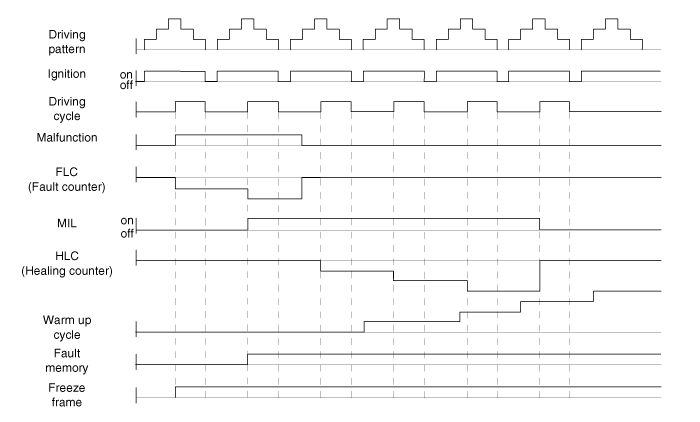Kia Niro: Engine Control System / Description and operation
| Description |
If the Gasoline Engine Control system components (sensors, ECM, injector, etc.) fail, interruption to the fuel supply or failure to supply the proper amount of fuel for various engine operating conditions will result. The following situations may be encountered.
| 1. |
Engine is hard to start or does not start at all. |
| 2. |
Unstable idle. |
| 3. |
Poor driveability |
If any of the above conditions are noted, first perform a routine diagnosis including the basic engine checks (ignition system malfunction, incorrect engine adjustment, etc.). Then, inspect the Gasoline Engine Control system components with the KDS/GDS.
|
Malfunction Indicator Lamp (MIL)
[EOBD]
A malfunction indicator lamp illuminates to notify the driver that there is a problem with the vehicle. However, the MIL will go out automatically after 3 sequential driving cycles without the same malfunction. Immediately after the ignition switch is turned on (ON position without starting), the MIL will illuminate continuously to indicate that the MIL operates normally.
Faults with the following items will illuminate the MIL.
| • |
Catalyst |
| • |
Fuel system |
| • |
Manifold Absolute Pressure Sensor (MAPS) |
| • |
Intake Air Temperature Sensor (IATS) |
| • |
Engine Coolant Temperature Sensor (ECTS) |
| • |
Throttle Position Sensor (TPS) [integrated into ETC Module] |
| • |
Upstream Oxygen Sensor |
| • |
Upstream Oxygen Sensor Heater |
| • |
Downstream Oxygen Sensor |
| • |
Downstream Oxygen Sensor Heater |
| • |
Injector |
| • |
Misfire |
| • |
Crankshaft Position Sensor (CKPS) |
| • |
Camshaft Position Sensor (CMPS) |
| • |
Evaporative Emission Control System |
| • |
Vehicle Speed Sensor (VSS) |
| • |
ETC Motor [integrated into ETC Module] |
| • |
Power Supply |
| • |
ECM/ PCM |
| • |
MT Encoding |
| • |
Acceleration Sensor |
| • |
MIL-on Request Signal |
| • |
Power Stage |
Refer to "Inspection CHART FOR DIAGNOSTIC TROUBLE CODES (DTC)" for more information. |
[NON-EOBD]
A malfunction indicator lamp illuminates to notify the driver that there is a problem with the vehicle. However, the MIL will go out automatically after 3 sequential driving cycles without the same malfunction. Immediately after the ignition switch is turned on (ON position without starting), the MIL will illuminate continuously to indicate that the MIL operates normally.
Faults with the following items will illuminate the MIL
| • |
Heated oxygen sensor (HO2S) |
| • |
Manifold Absolute Pressure Sensor (MAPS) |
| • |
Throttle Position Sensor (TPS) [integrated into ETC Module] |
| • |
Engine coolant temperature sensor (ECTS) |
| • |
ETC Motor [integrated into ETC Module] |
| • |
Injectors |
| • |
ECM |
Refer to "Inspection CHART FOR DIAGNOSTIC TROUBLE CODES (DTC)" for more information. |
[Inspection]
| 1. |
After turning ON the ignition key, ensure that the light illuminates for about 5 seconds and then goes out. |
| 2. |
If the light does not illuminate, check for an open circuit in the harness, a blown fuse or a blown bulb. |
Self-Diagnosis
The ECM monitors the input/output signals (some signals at all times and the others under specified conditions). When the ECM detects an irregularity, it records the diagnostic trouble code, and outputs the signal to the Data Link connector. The diagnosis results can be read with the MIL or HI-SCAN (Pro). Diagnostic Trouble Codes (DTC) will remain in the ECM as long as battery power is maintained. The diagnostic trouble codes will, however, be erased when the battery terminal or ECM connector is disconnected, or by the HI-SCAN (Pro).
If a sensor connector is disconnected with the ignition switch turned on, the diagnostic trouble code (DTC) is recorded. In this case, leave the negative (-) battery terminal disconnected for 15 seconds or more until the diagnostic memory is erased. |
Relationship between DTC and Driving Pattern in EOBD System

| 1. |
When the same malfunction is detected and maintained during two sequential driving cycles, the MIL will automatically illuminate. |
| 2. |
The MIL will go out automatically if no fault is detected after 3 sequential driving cycles. |
| 3. |
A Diagnostic Trouble Code (DTC) is recorded in ECM memory when a malfunction is detected after two sequential driving cycles. If a misfire is detected, a DTC will be recorded, and the MIL will illuminate, immediately after a fault is first detected. |
| 4. |
A Diagnostic Trouble Code (DTC) will be automatically erased from ECM memory if the same malfunction is not detected for 40 driving cycles. |
|
 Components and components location
Components and components location
Components Location
1. Engine Control Module (ECM)
2. Manifold Absolute Pressure Sensor (MAPS)
3. Mass Air Flow Sensor (MAFS)
4. Intake Air Temperature Sensor ...
 Engine Control Module (ECM) Schematic diagrams
Engine Control Module (ECM) Schematic diagrams
ECM Terminal And Input/Output
signal
ECM Terminal Function
Connector [A]
Pin No.
Description
Connected to
1
...
Other information:
Kia Niro (DE HEV) Owners Manual: Windshield washers
■ Type A
■ Type B
In the OFF (O) position, pull the lever gently toward you to spray washer fluid
on the windshield and to run the wipers 1-3 cycles.
Use this function when the windshield is dirty.
The spray and wiper operation will continue until you release the lever.
If the washer ...
Kia Niro 2017 (DE HEV) Service Manual: Front Driveshaft Repair procedures
Removal
1.
Remove the wheel and tire.
Tightening torque:
107.9 - 127.5 N·m (11.0 - 13.0 kgf·m, 79.6 - 94.0 lb·ft)
Be care ...

